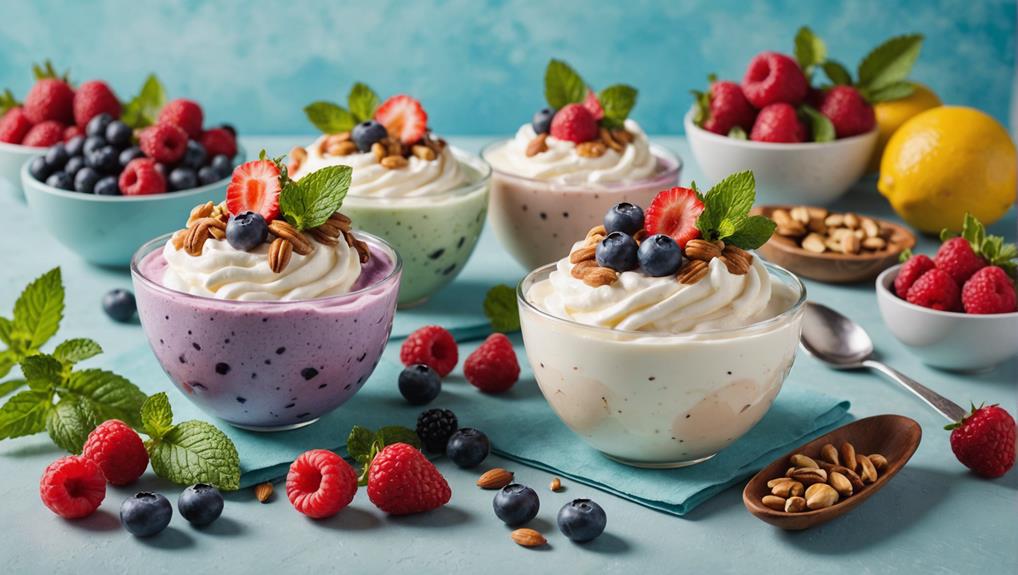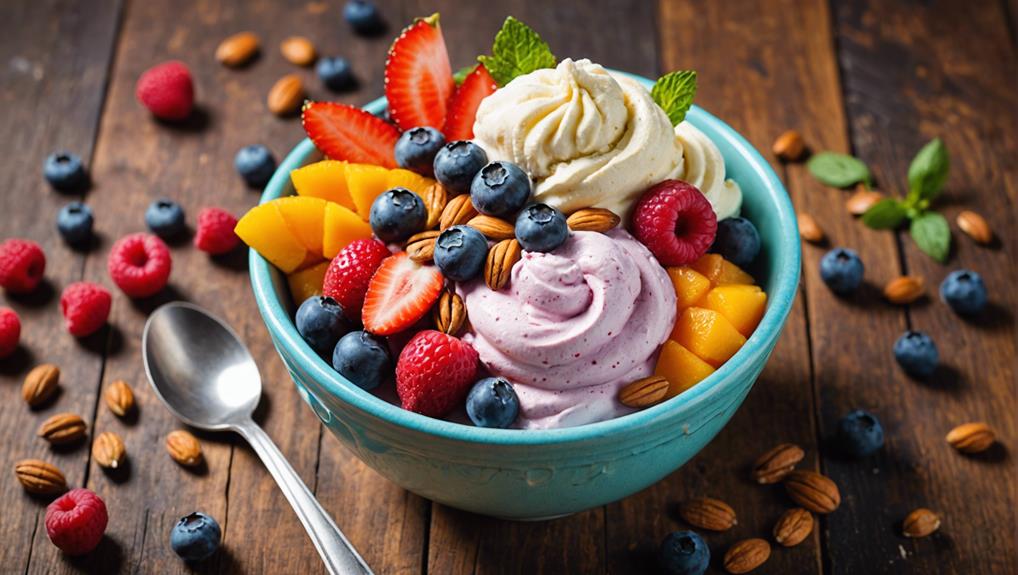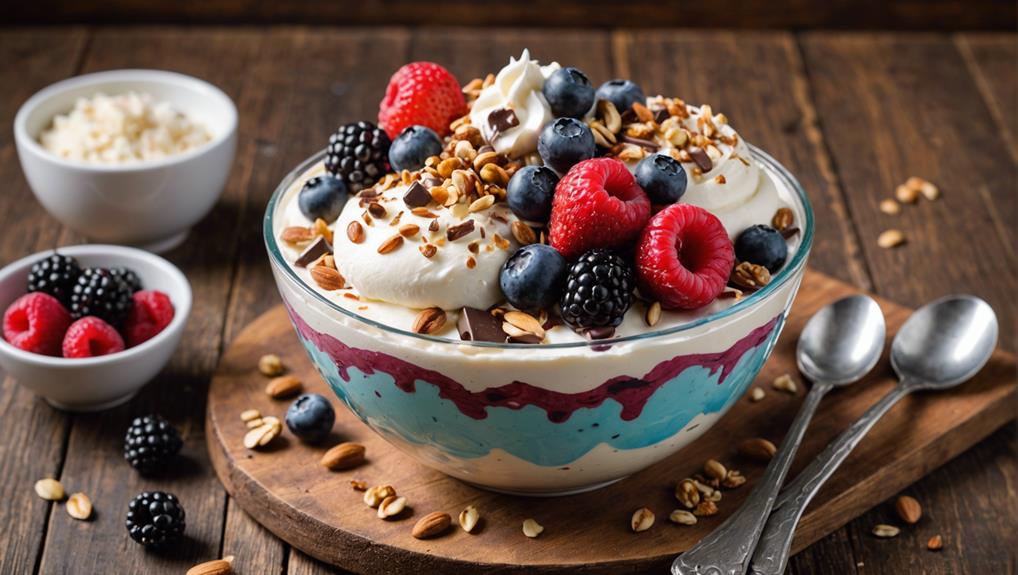Vegan frozen yogurt provides a nutritious and appetizing option for those on special diets. Using almond milk yogurt or coconut yogurt guarantees a vegan-friendly base, while natural sweeteners like Medjool dates and coconut sugar cater to individuals monitoring their glycemic index. Blending plant-based ingredients, freezing the mixture, and utilizing superfoods like spirulina can enhance both flavor and nutritional content. Proper storage techniques, such as using freezer-safe containers and portioning, maintain texture and nutritional value. Fresh fruits, crunchy nuts, and natural drizzles offer ideal topping choices. Discover more on creating the perfect vegan frozen yogurt tailored to your dietary needs.
Key Takeaways
- Use almond milk yogurt for a vegan-friendly and dairy-free frozen yogurt base.
- Sweeten naturally with Medjool dates or maple syrup for lower glycemic impact.
- Add plant-based protein powders to boost protein content.
- Incorporate superfoods like spirulina for added nutrients and antioxidants.
- Store in an airtight container in the freezer to maintain texture and freshness.
Ingredients and Substitutions

When crafting vegan frozen yogurt, utilizing thick coconut yogurt such as CocoJune or Culina can provide a creamy texture, while full-fat thick Greek yogurt can be used as a richer alternative. The choice between coconut yogurt and Greek yogurt will greatly impact the nutritional profile and texture of the final product. Coconut yogurt, being plant-based, aligns with vegan dietary preferences. Greek yogurt, though not vegan, offers a protein-rich option for those who include dairy in their diet.
Medjool dates serve as an excellent natural sweetener, replacing refined sugars and adding a depth of flavor. This alternative not only reduces the glycemic impact but also contributes dietary fiber, making the frozen yogurt a healthier indulgence. Vanilla extract, a universally appreciated flavor enhancer, pairs well with both types of yogurt, augmenting the sensory experience.
Incorporating coconut sugar offers a lower glycemic index compared to traditional sugars, aligning with a more health-conscious approach. For added texture and indulgence, mix-ins such as chocolate chips can be included. Alternatively, almond milk yogurt can serve as a lighter, vegan-friendly base, accommodating those with specific dietary restrictions or preferences.
Step-by-Step Instructions
To create a delicious and nutritionally balanced vegan frozen yogurt, follow these step-by-step instructions to guarantee the best texture and flavor. Begin by blending your chosen plant-based yogurt with a food processor until smooth. For ideal sweetness and a hint of flavor, add a tablespoon of maple syrup and a teaspoon of vanilla extract. Taste and adjust the sweetness if necessary, ensuring to balance it appropriately, as excess sweetener cannot be removed.
Once you have your yogurt mixture prepared, pour it into a shallow, freezer-safe container. For best results, use a container in the freezer that allows the mixture to spread evenly, ensuring uniform freezing. Place the container in the freezer and let the yogurt freeze for 2-3 hours or overnight until firm.
After freezing, break or cut the frozen yogurt into squares for easy serving. This Frozen Yogurt Recipe can be customized with toppings such as granola, fruits, nuts, seeds, or chocolate chips to enhance flavor and texture. Store any remaining vegan frozen yogurt bark in an airtight container in the freezer to maintain freshness for 5-7 days. Let me know if you need further assistance with this process.
Flavor Variations

Exploring different flavor variations can greatly enhance the nutritional profile and sensory appeal of vegan frozen yogurt. Integrating diverse fruit flavors, such as mango, pineapple, and mixed berries, not only offers variety but also enriches the dessert with essential vitamins and antioxidants. Additionally, incorporating plant-based protein powders can markedly boost the protein content, making it suitable for those observing Special Diets.
Moreover, the addition of superfoods like spirulina, matcha, and acai can provide a substantial health boost, infusing the frozen yogurt with beneficial nutrients and antioxidants. Experimenting with unique flavor combinations, such as lavender honey, chai spice, or mocha swirl, can elevate the culinary experience, offering a sophisticated twist to traditional vegan frozen yogurt.
Utilizing alternative sweeteners, such as agave nectar, coconut sugar, or stevia, allows for a customized taste profile while catering to varying dietary needs. These sweeteners provide a healthier option compared to conventional sugars, aligning with the health-conscious ethos of vegan and Special Diets.
| Flavor Element | Examples | Nutritional Benefits |
|---|---|---|
| Fruit Flavors | Mango, Pineapple, Berries | Vitamins, Antioxidants |
| Plant-Based Proteins | Protein Powders | Enhanced Protein Content |
| Superfoods | Spirulina, Matcha, Acai | Nutrient-Dense, Rich in Antioxidants |
Storage Tips
Proper storage techniques are essential to maintain the quality and freshness of vegan frozen yogurt. To guarantee the best texture and flavor, store your vegan frozen yogurt in a freezer-safe container immediately after preparation with an ice cream maker. Using containers designed for freezer storage helps to prevent ice crystals from forming, which can compromise the creamy texture typically desired in yogurt ice made with coconut milk or other plant-based creams.
For best freshness, vegan frozen yogurt should be consumed within 5-7 days. This timeframe ensures the product retains its desirable creamy consistency and nutritional value. If you plan to enjoy the frozen yogurt over several days, consider portioning it into individual servings. This reduces the need for repeated thawing and refreezing, which can degrade quality.
Thawing the frozen yogurt slightly before serving can enhance its texture, making it smoother and more enjoyable. Alternatively, consider making frozen yogurt bark by spreading the mixture thinly on a cookie sheet. This method allows for quick access and consumption within 24-48 hours, providing a convenient and nutritious treat.
Following proper storage practices helps maintain the integrity of your vegan frozen yogurt, ensuring each serving is as delightful as the first.
Topping Ideas

How can you enhance the nutritional profile and flavor of your vegan frozen yogurt? By thoughtfully selecting toppings, you can transform your sweet treat into a nutrient-dense delight. Depending on what kind of yogurt you use as the base, toppings can add essential vitamins, minerals, and textures that elevate both the culinary and health aspects of your dessert.
Fresh fruits like berries, mango, or banana slices not only introduce a burst of flavor but also provide antioxidants and fiber. For a crunchy element, consider granola, chopped nuts, or seeds like chia or hemp seeds. These additions offer essential fatty acids and protein, making your nice cream both satisfying and nutritious.
To further enhance the flavor profile, a drizzle of agave or maple syrup can add a touch of sweetness without relying on cane sugar. Alternatively, a swirl of nut butter can introduce a creamy, decadent finish. For a fun and visually appealing twist, sprinkle with coconut flakes, cacao nibs, or even edible flowers.
- Fresh Fruits: Adds natural sweetness and essential nutrients.
- Crunchy Elements: Provides texture and additional nutrients.
- Sweet Drizzles: Enhances flavor without excessive cane sugar.
Store your topped yogurt in an air-tight container to maintain freshness and flavor.
Frequently Asked Questions
Can I Eat Frozen Yogurt on a Diet?
Yes, you can eat frozen yogurt on a diet by considering calorie count, sugar content, and portion control. Opt for high-quality ingredients, low-carb options, and dairy alternatives to maximize nutritional benefits and support digestive health.
Does Vegan Yogurt Freeze Well?
Yes, vegan yogurt freezes well. The fermentation process and ingredient selection, including plant-based cultures and dairy alternatives, maintain texture differences, probiotic benefits, and flavor variations. Consult yogurt brands and storage tips for best homemade recipes.
Can You Freeze Yogurt and Eat It Like Ice Cream?
Reveal a world of flavor by freezing yogurt; it can indeed be eaten like ice cream! Utilize specific freezing techniques to maintain yogurt consistency, experiment with ingredient substitutions, and explore diverse flavor combinations to maximize health benefits.
Is Frozen Yogurt Less Fattening Than Ice Cream?
Frozen yogurt generally offers lower calorie content, sugar levels, and fat compared to ice cream, making it a healthier alternative for weight management. However, nutritional comparison varies by brand and toppings choice should be mindful for portion control.
Conclusion
To conclude, crafting vegan frozen yogurt suitable for special diets combines creativity with nutritional wisdom. By carefully selecting ingredients and employing precise techniques, one can create a versatile, health-conscious dessert. Flavor variations and topping suggestions further enhance the culinary experience, catering to diverse palates. Proper storage guarantees longevity, allowing for enjoyment over multiple servings. This endeavor not only satisfies dietary restrictions but also transforms the simple pleasure of frozen yogurt into an inclusive, gourmet indulgence.







